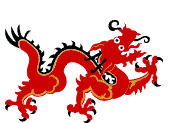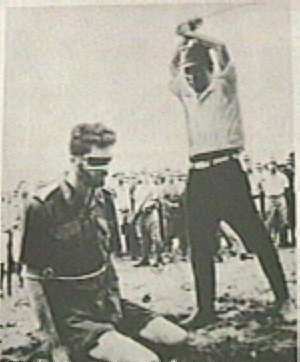Australian
Officer being beheaded by Japanese Soldier.
105th Congress - House
Concurrent Resolution 126
[Japanese War Crimes] HCON 126 IH
IN
THE HOUSE OF REPRESENTATIVES Mr. LIPINSKI (for himself, Mr.
STUMP, Mrs. MORELLA, Ms. LOFGREN, Mr. SKEEN, Mr. WATTS of Oklahoma, Mr.
CAMPBELL, Mrs. MALONEY of New York, Mr. UNDERWOOD, Mr. TOWNS, Mr.
ROHRABACHER, Mr. GREEN, Mr. HILL, Mr. ETHERIDGE, Mr. ACKERMAN, and Mr.
YATES) submitted the following concurrent resolution; which was referred
to the Committee on International Relations
CONCURRENT RESOLUTION
Whereas during World War II the
Government of Japan deliberately ignored and flagrantly violated the
Geneva and Hague Conventions and committed atrocious crimes against
humanity;
Whereas 33,587 members of the
United States Armed Forces and 13,966 United States civilians were
captured by the Japanese military in the Pacific Theater during World
War II, confined in brutal prison camps, and subjected to severe
shortages of food, medicine, and other basic necessities;
Whereas many of the United States
military and civilian prisoners of the Japanese military during World
War II were subjected to forced labor, starved and beaten to death, or
summarily executed by beheading, firing squads, or immolation;
Whereas almost all of the United
States military and civilian prisoners who were rescued from the
Japanese military at the end of World War II were afflicted with
diseases caused by malnutrition and deprivation and have suffered from
life-long illnesses, psychological and emotional trauma, and financial
hardships as a result of their experience during the war;
Whereas, of the United States
prisoners held by the German military during World War II, 1.1 percent
of the military prisoners and 3.5 percent of the civilian prisoners died
during their imprisonment, but of the United States prisoners held by
the Japanese military, 37.3 percent of the military prisoners and 11
percent of the civilian prisoners died during their imprisonment;
Whereas on December 8, 1941, the
Japanese military bombed and invaded the island of Guam and occupied the
island until the liberation of Guam by the United States Armed Forces on
July 21, 1944;
Whereas the people of Guam were
subjected to death, beheadings, rape and other violent acts, forced
labor and marches, and imprisonment by the Japanese military during the
occupation of Guam during World War II;
Whereas at the Japanese biochemical
warfare detachment in Mukden, Manchuria, commanded by Dr. Shiro Ishii,
experiments were conducted on living prisoners of war that included
infecting prisoners with deadly toxins, including plague, anthrax,
typhoid, and cholera;
Whereas at least 260 of the 1,500
United States prisoners believed to have been held at Mukden died during
the first winter of their imprisonment and many of the 300 living
survivors of Mukden claim to suffer from physical ailments resulting
from their subjection to chemical and biological experiments;
Whereas the Japanese military
invaded Nanjing, China, from December, 1937, until February, 1938,
during the period known as the `Rape of Nanjing', and brutally and
systematically slaughtered more than 300,000 Chinese men, women, and
children and raped more than 20,000 women;
Whereas the Japanese military
enslaved millions of Koreans during World War II and forced hundreds of
thousands of women into sexual slavery for Japanese troops;
Whereas international jurists in
Geneva, Switzerland ruled in 1993 that women who were forced to be
sexual slaves of the Japanese military during World War II (known by the
Japanese military as comfort women) deserve at least $40,000 each
as compensation for their `extreme pain and suffering';
Whereas the Government of Germany
has formally apologized to the victims of the Holocaust and gone to
great lengths to provide financial compensation to the victims and to
provide for their needs and recovery; and
Whereas by contrast the Government
of Japan has refused to fully acknowledge the crimes it committed during
World War II and to provide reparations to its victims: Now, therefore,
be it
Resolved by the House
of Representatives (the Senate concurring), That it is the sense of
Congress that the Government of Japan should-- (1) formally issue a clear and
unambiguous apology for the atrocious war crimes committed by the
Japanese military during World War II; and (2) immediately pay reparations to
the victims of those crimes, including United States military and
civilian prisoners of war, people of Guam who were subjected to violence
and imprisonment, survivors of the `Rape of Nanjing' from December,
1937, until February, 1938, and the women who were forced into sexual
slavery and known by the Japanese military as "comfort women". UKUOKA, Japan "I could never again
wear a white smock," says Dr. Toshio Tono, dressed in a white running
jacket at his hospital and recalling events of 50 years ago. "It's
because the prisoners thought that we were doctors, since they could see
the white smocks, that they didn't struggle. They never dreamed they
would be dissected." The prisoners were eight American
airmen, knocked out of the sky over southern Japan during the waning
months of World War U, and then torn apart organ by organ while they
were still alive. What occurred here 50 years ago
this month, at the anatomy department of Kyushu University, has been
largely forgotten in Japan and is virtually unknown in the United
States. American prisoners of war were subjected to horrific medical
experiments. All of the prisoners died. Most of the physicians and
assistants then did their best to hide the evidence of what they had
done. Fukuoka is midway between Hiroshima and Nagasaki, cities that are
planning elaborate ceremonies to mark the devastation caused by the
United States dropping the first atomic bombs. But neither Fukuoka nor
the university plans to mark its own moment of infamy. The gruesome experiments performed
at the university were variations on research programs Japan conducted
in territories it occupied during the war. In the most notorious of
these efforts, the Japanese Imperial Army's Unit 731 killed thousands of
Chinese and Russians held prisoner in Japanese-occupied Manchuria, in
experiments to develop chemical and biological weapons. Ken Yuasa, now a frail,
70-year-old physician in Tokyo, belonged to a military company stationed
just south of Unit 731's base at Harbin, Manchuria. He recalls joining
other doctors to watch as a prisoner was shot in the stomach, to give
Japanese surgeons practice at extracting bullets. While the victim was
still alive, the doctors also practiced amputations. "It wasn't just my
experience," Yuasa says. "It was done everywhere." Kyushu University stands out as the
only site where Americans were incontrovertibly used in dissections and
the only known site where experiments were done in Japan. On May 5, 1945, an American B-29
bomber was flying with a dozen other aircraft after bombing Tachiaral
Air Base in southwestern Japan and beginning the return flight to the
island fortress of Guam. Kinzou Kasuya, a 19-year-old Japanese pilot
flying one of the Japanese fighters in pursuit of the Americans, rammed
his aircraft into the fuselage of the B-29, destroying both planes. No one knows for certain how many
Americans were in the B-29; its crew had been hastily assembled on Guam.
But villagers in Japan who witnessed the collision in the air saw about
a dozen parachutes blossom. One of the Americans died when the cords of
his, parachute were severed by another Japanese plane. A second was
alive when he reached the ground. He shot all but his last bullet at the
villagers coming toward him, then used the last on himself. Two others
were quickly stabbed or shot to death. At least nine were taken into
custody. B-29 crews were despised for the grim results of their raids.
So some of the captives were beaten. The local authorities assumed that
the Captain Marvin Meyers was the most knowledgeable. He was sent
to Tokyo for interrogation, where was tortured but nonetheless survived
the war. Every available account asserts
that a military physician and a colonel in a local regiment were the two
key figures in what happened next. What happened cannot be easily
explained. Perhaps caring for the Americans was an impossible burden,
especially because some were injured. Perhaps food was scarce. Whatever
the reason, the colonel and doctor decided to make the prisoners
available for medical experiments, and Kyushu University became a
willing participant. Teddy Ponczka was the first to be
handed over to the doctors and their assistants. He had already been
stabbed, in either his right shoulder or his chest. According to Tono,
the American assumed he was about to be treated for the wound when he
was taken to an operating room. But the incision went far deeper.
A doctor wanted to test surgery's effects on the respiratory system, so
one lung was removed. The wound was stitched closed. How Teddy Ponczka
died is in dispute. According to U.S. military records, he was
anesthetized during the operation, and then the gas mask was removed
from his face. A surgeon, Taro Torisu, reopened the incision and reached
into Ponczka's chest. In the bland words of the military report, Torisu
"stopped the heart action. " Tono remembers events differently.
The first experiment was followed by a second, he says. Ponczka was
given intravenous injections of sea water, to determine if sea water
could be used as a substitute for sterile saline solution, used to
increase blood volume in the wounded or those in shock. Tono held the
bottle of sea water. He says Ponczka bled to death. Then it was the turn of the
others. The Japanese wanted to learn whether a patient could survive the
partial loss of his liver. They wanted to learn if epilepsy could be
controlled by removing part of the brain. According to U.S. military
records, physicians also operated on -the prisoners' stomachs and necks.
All the Americans died. "There was no debate among the
doctors about whether to do the operations - that is what made it so
strange," Tono says. Word of the experiments eventually leaked out. Thirty people were brought to
trial by an Allied war crimes tribunal in Yokohama, Japan, on March 11,
1948. Charges included vivisection, wrongful removal of body parts and
cannibalism - based on reports that the experimenters had eaten the
livers of the Americans. Of the 30 defendants, 23 were found guilty of
various charges. (For lack of proof, the charges of cannibalism had been
dismissed.) Five of the guilty were sentenced to death, four to life
imprisonment. The other 14 were sentenced to shorter terms. But the attitude of the American
occupation forces began to change largely because of the start of the
Korean War in June 1950. The United States had less interest in
punishing Japan, an enemy turned ally. In September 1950, U.S. Gen.
Douglas MacArthur, as supreme commander for Allied Forces, reduced most
of the sentences. By 1958, all those convicted were free. None of the
death sentences was carried out. Do your own research!
An internet search of Japanese War Crimes will result in numerous web
sites to visit. Make sure the youth of today don't just hear the
liberals who whine about the use of nuclear bombs on the poor Japanese
|


